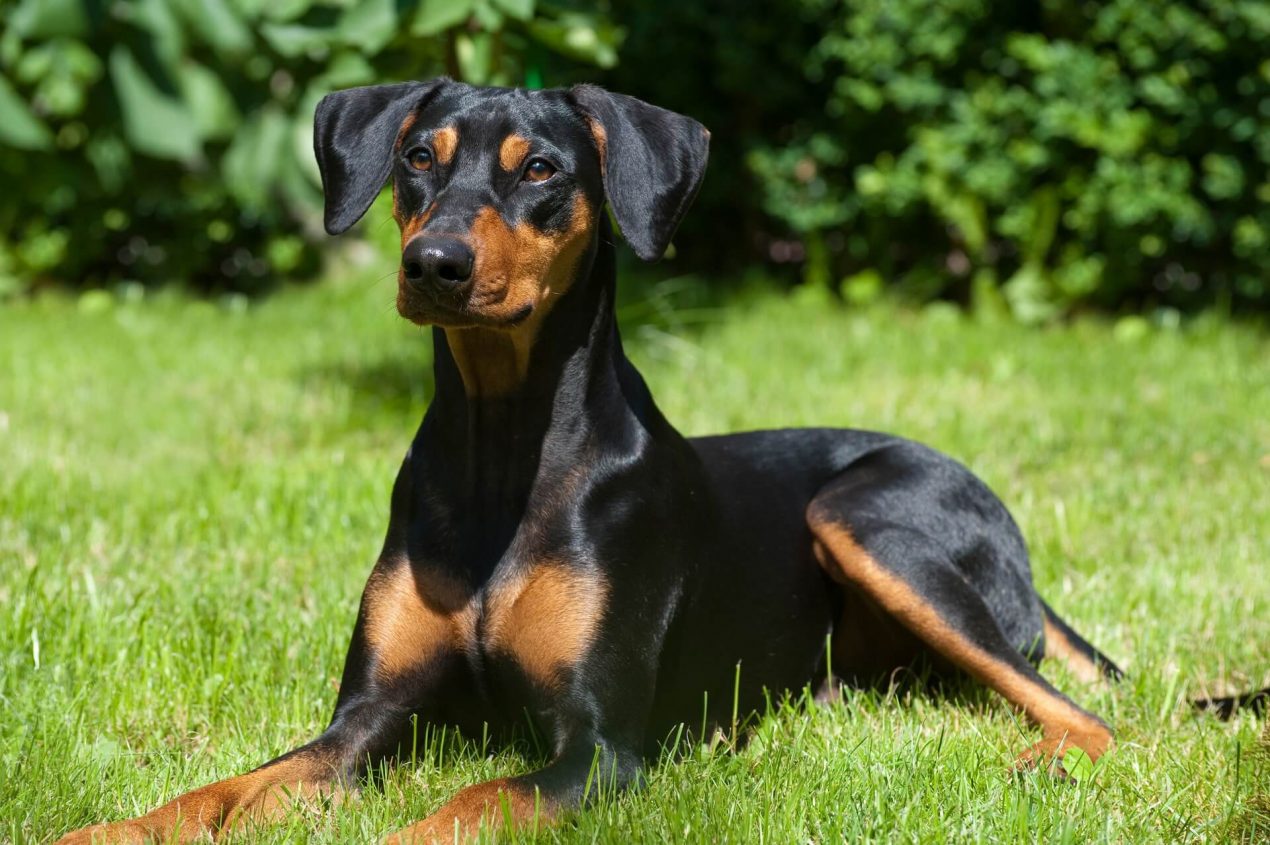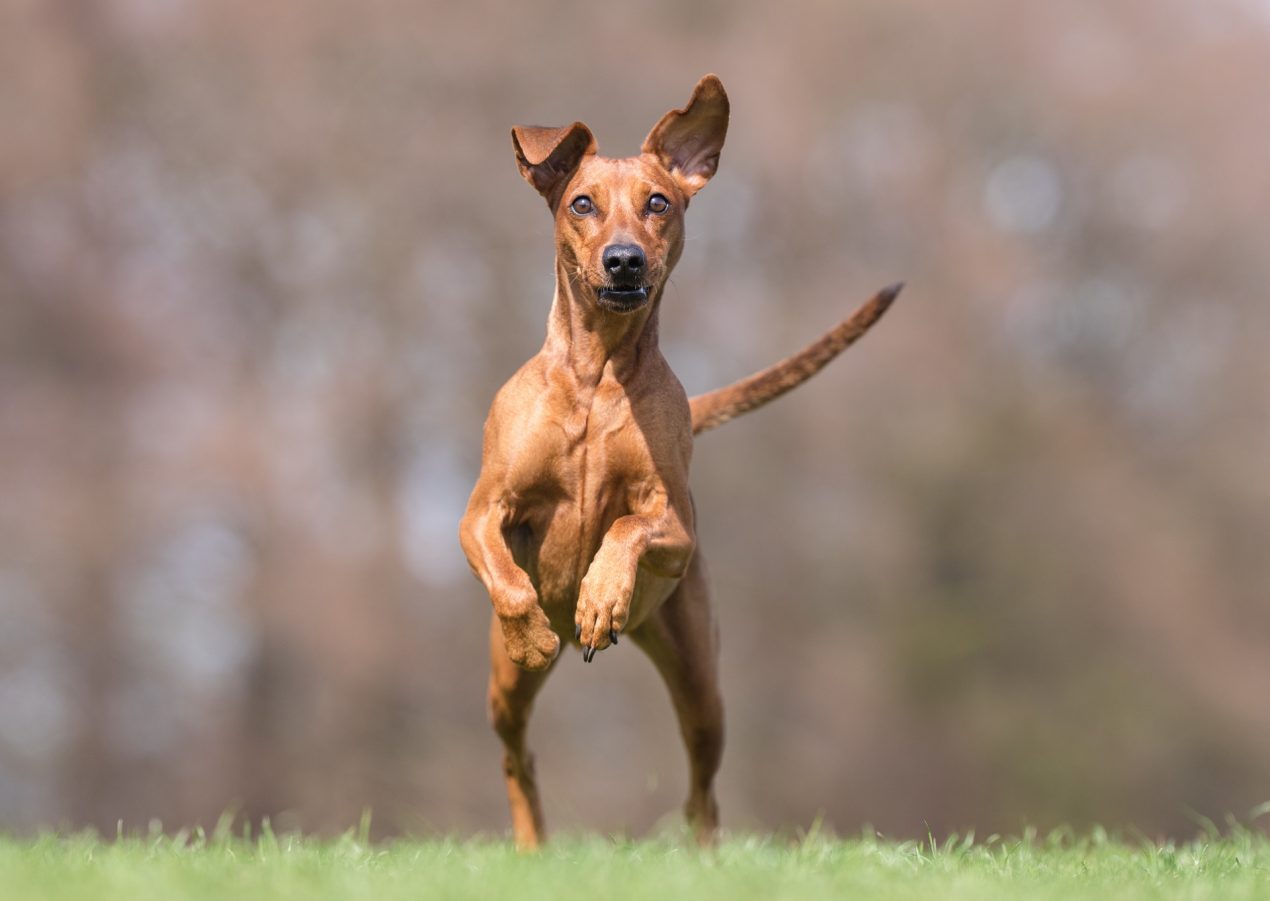German Pinschers are smart, affectionate, loyal, and cuddly. They are often touted as the ideal family dog. And they can indeed become one if training is loving, consistent, and patient, and if these energetic dogs are adequately exercised.
History of the German Pinscher
The German Pinscher, an impressive breed with a rich history, has evolved and transformed over centuries. Here, you will learn more about its origins, its role in the past, and its path to current popularity.
The origins of the German Pinscher are diverse and fascinating. Some theories suggest that its ancestors were the “Torfhunde” that lived in southern Germany 3,000 years ago. Others believe that the Pinscher descends from terriers from Great Britain or has its roots in the Austrian Pinzgau. However, all theories share the realization that the ancestors of the Pinscher were widespread on farms and estates, where they played an important role. They kept stables free of rats and were loyal companions to coaches and wagons, often covering long distances of up to 20 kilometers.
Developments in the 19th and 20th Centuries:
The breed first appeared in the German studbook in 1880. 1895 was a significant year for the Pinscher, as the Pinscher Club was founded. At that time, both rough-haired and smooth-haired variants were allowed for breeding. The rough-haired variant later became known as the “Schnauzer,” and in 1917, the official separation of the two types occurred. These two breeds are still united today in the Pinscher-Schnauzer Club 1895.
Decline and Revival of the Breed:
After World War II, the German Pinscher faced extinction. Thanks to the efforts of breed enthusiasts like Werner Jung, who bred oversized Miniature Pinschers among other efforts, the breed was saved. A significant moment for the popularity of the German Pinscher was in 2003 when it was chosen as the endangered livestock breed of the year by the Society for the Conservation of Old and Endangered Livestock Breeds.
Today, the German Pinscher has evolved from a barn and carriage dog into a loyal companion for active people. Its versatility and history make it a unique and valued breed in the world of dogs.
This exciting history of the German Pinscher demonstrates how the breed has evolved and adapted over centuries. From a useful helper on the farm to a beloved family member, the German Pinscher has a rich past and a promising future.
Breed Overview
GROUP: Working
HEIGHT: 17 to 20 inches
WEIGHT: 25 to 45 pounds
COAT: Short, smooth
COAT COLOR: Black, blue, fawn, or red with tan and/or red markings
LIFE SPAN: 12 to 14 years
TEMPERAMENT: Energetic, affectionate, courageous
HYPOALLERGENIC: No
ORIGIN: Germany
Appearance of the German Pinscher
The German Pinscher, a medium-sized dog with a distinctive appearance, fascinates with its athletic stature and versatile personality. Here, you will learn all about its size, weight, and physical characteristics that make it so unique.
Size and Weight:
The German Pinscher is an example of perfect proportions in the medium-sized dog class. With a withers height of 45 to 50 centimeters, it brings an ideal balance between size and agility. You should note that the weight of this breed ranges between 14 and 20 kilograms, with some dogs reaching up to 20 kilograms. This range demonstrates the natural variability within the breed.
Body Structure and Coat:
The muscular body structure and short, smooth coat are characteristic of the German Pinscher. This coat, which varies in colors from solid red to multicolored black and red, gives it a shiny and well-groomed appearance. This diversity in coat color makes each Pinscher unique.
Head Shape and Facial Expression:
The head of the German Pinscher is triangular, with a moderate stop and a long muzzle. This structure gives its face an expressive and intelligent character. The ears, which are set high and folded forward, along with its dark brown eyes that radiate a vigilant and attentive gaze, complete its charismatic appearance.
Nature and Character
The German Pinscher is considered lively, intelligent, active, and attentive. In the house and among its family, it is very affectionate. It is very loyal and demands attention from its human whenever it wants it. Children in the family should be somewhat older and able to understand the needs of the animal. As a dog whose ancestors had to fend for themselves, it is very independent and self-assured. Some accuse it of being stubborn. It is reputed to be stubborn and only follows commands if it considers them right.
If it feels unfairly treated, it tends to be defiant. Its hunting instinct is very pronounced, and at the sight of potential prey, it may forget all obedience. Its protective instinct is also strong, and it is initially suspicious of strangers. Its interaction with other dogs depends on sympathy. It must be accustomed to cats and small animals from an early age; otherwise, it will see them as prey.
| Affection Level | High |
| Friendliness | Medium |
| Kid-Friendly | Medium |
| Pet-Friendly | Medium |
| Exercise Needs | High |
| Playfulness | High |
| Energy Level | High |
| Trainability | High |
| Intelligence | High |
| Tendency to Bark | Medium |
| Amount of Shedding | Medium |
Acquisition of a German Pinscher
Are you considering getting a German Pinscher? In principle, this is a good choice, but you must consider some things. A German Pinscher requires a lot of attention. Outside, it demands sports and play, and indoors, it demands cuddle sessions. Can you spare this time? Do you already have experience in training a dog? Because you must convey to your German Pinscher that you are the pack leader, which is difficult with this self-assured and responsible dog. You should definitely have some experience.

What should I look out for when buying?
Even today, the German Pinscher is still a relatively rare breed. You must be prepared to wait longer to get a puppy because breeders often already have waiting lists. You may also have to travel a longer distance. Under no circumstances should you succumb to the temptation of acquiring a supposedly cheap puppy from the internet. Often, the papers of these animals are forged, and the young dogs are already sick because they were separated from their mother much too early so that she can be mated as quickly as possible to produce new puppies and boost business further.
You can recognize a reputable breeder by the fact that they allow you to visit them and meet the mother and siblings of your puppy. They will answer all your questions and support you with advice and action even after the purchase. A good indication of whether a breeder is reputable is usually membership in the American Kennel Club (AKC).
Requirements for Prospective Owners
A German Pinscher is an active and energetic dog that requires both mental and physical challenges. You should be prepared to provide it with sufficient exercise and mental stimulation daily. This includes both outdoor physical activities and cuddle sessions indoors. A basic understanding of the breed and experience in dog training are essential to successfully lead a German Pinscher. Consistency and a certain level of firmness, without resorting to violence, are essential to avoid aggressive behavior.
Suitability for Different Living Situations
German Pinschers are adaptable and suitable for various living situations, whether it be a house with a garden or an apartment. It is important that they receive enough exercise to meet their high energy levels and adapt to life in urban or rural areas.
Puppy Development and Training
Despite their intelligence and willingness to learn, German Pinschers are not easy dogs and are difficult to train. They are hardly suitable for dog beginners. Puppies must be trained with love but also extreme consistency. These clever dogs will detect and exploit any inconsistency. Especially for such difficult-to-train breeds with a lot of stubbornness and self-assurance, attending a dog school can be helpful.
How to Keep a German Pinscher?
A German Pinscher is not a dog for the city. As a farm dog, it has always been outdoors in nature, and it still feels comfortable there today. Ideally, a house with a secured garden where it can guard is suitable. It is important that it receives enough exercise to meet its high energy levels and adapt to life in rural areas.

Activities with the German Pinscher
The agile German Pinscher would probably prefer to be in motion all day. It needs active people who challenge it both physically and mentally. It doesn’t really care which dog sport it does with its human; the main thing is that there is enough action. It is versatile and enjoys jogging, agility, outings with bicycles or horses, as well as mantrailing. Only with obedience, obedience exercises as a sport, can there be problems with the stubborn dog.
On the other hand, these exercises also mentally tire it out. So if you’re not aiming for medals with your German Pinscher and just want to have fun with it, that’s also a sport you can enjoy together with your dog. Everything is possible with the German Pinscher. Just one thing to avoid: letting it get bored. Because then it will find its own entertainment. And that can have unpleasant consequences for cushions, sofas, your apartment, and your garden.
Health and Care
The German Pinscher is known not only for its lively temperament but also for its low-maintenance nature. Learn here about the care, health aspects, and life expectancy of this robust breed.
Daily Care and Needs:
Caring for the German Pinscher is relatively straightforward. Its smooth, short coat only requires regular brushing, about once a week, to remove loose hair and dirt. Thanks to the lack of undercoat, shedding is minimal in this breed, and even the coat change is hardly noticeable. When grooming the coat, don’t forget about the ears; these should be checked and cleaned regularly.
Regarding nutrition, the Pinscher is uncomplicated, but you should adjust the amount and type of food to the dog’s weight, age, and individual needs. Puppies require a higher energy intake, while older dogs tend to need less food.
Health and Robustness:
One of the greatest advantages of the German Pinscher is its robust health. Since it was never a fashionable dog and consequently not overbred, it has been able to maintain its robustness. Breed-specific diseases are rare in this breed. The only condition that occurs more frequently in German Pinschers is ear margin necrosis, favored by the thin skin on the edges of the ears, especially in active dogs.
The life expectancy of the German Pinscher is an impressive range of 12 to 15 years. However, this range can vary depending on individual health, care, and nutrition. A well-groomed and healthily nourished German Pinscher can enjoy a long and happy life by your side.
Interesting Facts
German Pinschers can be seen in paintings from the Middle Ages and the Renaissance. Their appearance has hardly changed over all those centuries.
Do you have a German Pinscher or are you considering getting one? Tell us in the comments what you think makes them so special!


